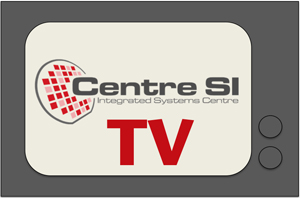Go to
April 5, 2016
IEL - Centre SI Joint Seminar
Memcomputing: a brain-inspired memory-enabled computing paradigm
Tuesday, 5 April 2016 at 14:15 in SV 1717A
Massimiliano Di Ventra, Department of Physics, University of California San Diego, La Jolla, California, USA
Abstract:
Which features make the brain such a powerful and energy-efficient computing machine? Can we reproduce them in the solid state, and if so, what type of computing paradigm would we obtain? I will show that a machine that uses memory to both process and store information, like our brain, and is endowed with intrinsic parallelism and information overhead - namely takes advantage, via its collective state, of the network topology related to the problem - has a computational power far beyond our standard digital computers [1]. We have named this novel computing paradigm “memcomputing” [2]. As an example, I will show the polynomial-time solution of prime factorization and the NP-hard version of the subset-sum problem using polynomial resources and self-organizable logic gates, namely gates that self-organize to satisfy their logical proposition [3]. These are examples of scalable digital memcomputing machines that can be easily realized with available nanotechnology components.
References:
[1] F. L. Traversa and M. Di Ventra, Universal Memcomputing Machines, IEEE Transactions on Neural Networks and Learning Systems, 26, 2702 (2015).
[2] M. Di Ventra and Y.V. Pershin, Computing: the Parallel Approach, Nature Physics, 9, 200 (2013).
[3] F. L. Traversa and M. Di Ventra, Polynomial-time solution of prime factorization and NP-hard problems with digital memcomputing machines, arXiv:1512.05064.
About the speaker:
 Massimiliano Di Ventra obtained his undergraduate degree in Physics summa cum laude from the University of Trieste (Italy) in 1991 and did his PhD studies at the Ecole Polytechnique Fédérale de Lausanne (Switzerland) in 1993-1997. He has been Research Assistant Professor at Vanderbilt University and Visiting Scientist at IBM T.J. Watson Research Center before joining the Physics Department of Virginia Tech in 2000 as Assistant Professor. He was promoted to Associate Professor in 2003 and moved to the Physics Department of the University of California, San Diego, in 2004 where he was promoted to Full Professor in 2006. Di Ventra's research interests are in the theory of electronic and transport properties of nanoscale systems, non-equilibrium statistical mechanics, DNA sequencing/polymer dynamics in nanopores, and memory effects in nanostructures for applications in unconventional computing and biophysics. He has been invited to deliver more than 200 talks worldwide on these topics (including 6 plenary/keynote presentations, 7 talks at the March Meeting of the American Physical Society, 5 at the Materials Research Society, 2 at the American Chemical Society, and 1 at the SPIE). He serves on the editorial board of several scientific journals and has won numerous awards and honors, including the NSF Early CAREER Award, the Ralph E. Powe Junior Faculty Enhancement Award, fellowship in the Institute of Physics and the American Physical Society. He has published more than 140 papers in refereed journals (13 of these are listed as ISI Essential Science Indicators highly-cited papers of the period 2003-2013), co-edited the textbook Introduction to Nanoscale Science and Technology (Springer, 2004) for undergraduate students, and he is single author of the graduate-level textbook Electrical Transport in Nanoscale Systems (Cambridge University Press, 2008).
Massimiliano Di Ventra obtained his undergraduate degree in Physics summa cum laude from the University of Trieste (Italy) in 1991 and did his PhD studies at the Ecole Polytechnique Fédérale de Lausanne (Switzerland) in 1993-1997. He has been Research Assistant Professor at Vanderbilt University and Visiting Scientist at IBM T.J. Watson Research Center before joining the Physics Department of Virginia Tech in 2000 as Assistant Professor. He was promoted to Associate Professor in 2003 and moved to the Physics Department of the University of California, San Diego, in 2004 where he was promoted to Full Professor in 2006. Di Ventra's research interests are in the theory of electronic and transport properties of nanoscale systems, non-equilibrium statistical mechanics, DNA sequencing/polymer dynamics in nanopores, and memory effects in nanostructures for applications in unconventional computing and biophysics. He has been invited to deliver more than 200 talks worldwide on these topics (including 6 plenary/keynote presentations, 7 talks at the March Meeting of the American Physical Society, 5 at the Materials Research Society, 2 at the American Chemical Society, and 1 at the SPIE). He serves on the editorial board of several scientific journals and has won numerous awards and honors, including the NSF Early CAREER Award, the Ralph E. Powe Junior Faculty Enhancement Award, fellowship in the Institute of Physics and the American Physical Society. He has published more than 140 papers in refereed journals (13 of these are listed as ISI Essential Science Indicators highly-cited papers of the period 2003-2013), co-edited the textbook Introduction to Nanoscale Science and Technology (Springer, 2004) for undergraduate students, and he is single author of the graduate-level textbook Electrical Transport in Nanoscale Systems (Cambridge University Press, 2008).
Secondary navigation
- January 29, 2018
- August 30, 2017
- Past seminars
- 2016 - 2017 Seminars
- 2015 - 2016 Seminars
- 2014 - 2015 Seminars
- 2013 - 2014 Seminars
- 2012 - 2013 Seminars
- 2011 - 2012 Seminars
- 2010 - 2011 Seminars
- 2009 - 2010 Seminars
- 2008 - 2009 Seminars
- 2007 - 2008 Seminars
- 2006 - 2007 Seminars
- August 31, 2007
- June 29, 2007
- June 20, 2007
- June 5, 2007
- May 30, 2007
- May 16, 2007
- May 15, 2007
- April 24, 2007
- March 27, 2007
- March 14, 2007
- February 9, 2007
- February 8, 2007
- January 12, 2007
- December 5, 2006
- November 14, 2006
- October 31, 2006
- October 27, 2006
- October 26, 2006
- October 20, 2006
- September 20, 2006
- September 20, 2006
- September 20, 2006
- September 19, 2006
- 2005 - 2006 Seminars
- August 23, 2006
- August 22, 2006
- June 26, 2006
- June 20, 2006
- June 16, 2006
- June 7, 2006
- June 6, 2006
- May 30, 2006
- May 17, 2006
- May 10, 2006
- April 27, 2006
- April 12, 2006
- March 31, 2006
- March 29, 2006
- March 22, 2006
- March 15, 2006
- February 27, 2006
- February 8, 2006
- January 25, 2006
- January 19, 2006
- January 18, 2006
- January 17, 2006
- January 11, 2006
- November 30, 2005
- November 23, 2005
- November 2, 2005
- October 26, 2005
- October 25, 2005
- October 5, 2005
- September 28, 2005
- 2005 Seminars
How to find SV 1717A
Conference room SV 1717A (SV 1717.1) access is thru the SV cafeteria "L'Ornithorynque".

